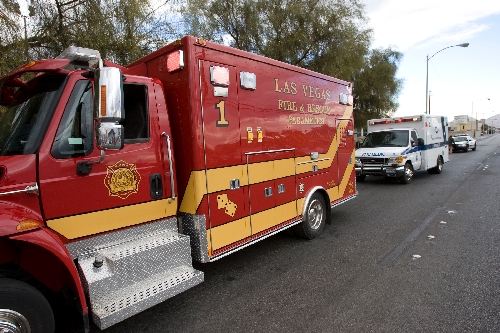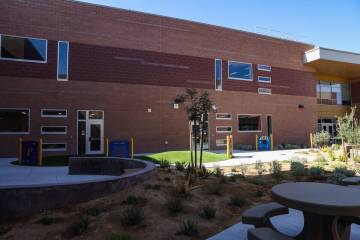‘Dual’ doesn’t always mean redundant
A few areas have resolved the duplications inherent in public/private "dual response" emergency medical services. The EMS role can be assigned entirely to private ambulance companies. Many jurisdictions, including the city of Henderson, have fire personnel provide emergency ambulance service as well as first response.
"Blended" systems also exhibit wrinkles specific to the locality, said John Wilson, general manager of American Medical Response, the ambulance company that provides emergency service in the Las Vegas Valley.
"When you've seen one EMS system," he quipped, "you've seen that one."
Las Vegas, North Las Vegas, and Clark County voluntarily belong to a regional franchise jurisdiction that establishes uniform practices for emergency medical services. Each of those jurisdictions negotiates its own emergency ambulance franchise contracts. MedicWest, the ambulance company that serves North Las Vegas, and Mercy, the one that serves Clark County and Las Vegas, are both owned by the same parent company, American Medical Response. Other ambulance companies are free to provide nonemergency transport.
By mutual agreement among participants, all responders to medical emergencies are dispatched by Las Vegas Fire Station No. 1. When someone calls the area-wide 911 system, operated by Las Vegas police at a different location, the person is asked whether the emergency is "police, fire or medical." If the answer is fire or medical, it is switched to the fire alarm office.
That dispatcher asks the location of the emergency and types it; locator software produces a map that will appear not only on her computer screen but also on the computers of emergency response units assigned to the call. The dispatcher then begins asking questions according to protocols which branch in different directions according to the last answer given. Anywhere in the United States, if the dispatcher asks, "Is the person conscious," and the answer is negative, the next question is, "Are they breathing?" If not, the dispatcher will always tell the caller how to do CPR. She doesn't ask whether the caller wishes to do CPR because it's better not to offer the option of saying, "I don't think I can!"
The protocols are the quickest way to determine the seriousness of the call .
Mike Tomko, the supervisor on duty the night a reporter visited, said the job is stressful. "Sometimes we have to talk people through CPR on the phone; sometimes they're having babies." It takes six or seven months to train a dispatcher.
Most people who phone in emergencies are untrained and offer too little information or too much; either can slow down identifying the problem and rolling appropriate help.
"A lot of our best callers are children. If you ask them a question they'll usually answer 'Yes' or 'No' without any back story."
A 2008 survey by the Journal of Emergency Medical Service found only 30 percent of EMS communication centers are accredited by any organization which sets standards, but the Las Vegas system is among that 30 percent.
On the private side, both Mercy and MedicWest have long met the standards of the Commission on Accreditation of Ambulance Services, as did only 21 percent of the transporting agencies responding to the JEMS survey.
Spokesmen for the Las Vegas, North Las Vegas, and Clark County fire departments express pride that nearly all fire personnel are cross-trained as EMTs, the widely accepted minimum standard for any person staffing an ambulance or fire department rescue unit.
For the Las Vegas department, Chief Greg Gammon said, even an applicant for hiring must have basic EMT training; completing the fire academy raises the newcomer to intermediate level. All three fire departments say that any team dispatched to a medical emergency also includes at least one paramedic, a rating reflecting a still higher level of training. For the ambulance company, the standard of one paramedic and one intermediate EMT or higher is a minimum written into its contract with Clark County.
The fire departments and ambulance company are proud of response times.
"Our goal is 4 to 6 minutes and we average it," Gammon said. "But there are a lot of variables; just the time of day an incident happens, and the traffic patterns at that time and place, make a big difference."
There's a widely accepted national standard that first responders should arrive within 7 minutes, 59 seconds, on 90 percent of their siren-and-lights runs. Clark County Fire Department units beat that by 12 seconds, according to Scott Allison, the department spokesman.
"In fact, they say if you're going to experience a cardiac arrest, the best place to do it is a Strip hotel because we can get there quick, and also because their own guys at the hotels are trained and equipped to deal with it," Allison said.
The high quality of the local dual system is widely acknowledged.
Wilson rose to run the ambulance company from working his way through college as an EMT and was one of the founders of MedicWest. He is 42, and came to Las Vegas 17 years ago.
"I'm a believer in this system," he said. "There should be paramedics in the fire department, and there should be paramedics in the private sector. ... If you're an injured person, what you really want out of an EMS system is for somebody to get there fast, and you don't much care which one it is. The fire department mission is quick response and then getting back into service to cover the next emergency. Ours includes transport, and our time in service for each call tends to be rather greater."
He continued, "An important thing for everybody to understand is that Las Vegas is an island, and when the next big bad thing happens -- I don't know what the bad thing will be -- we'll come together very well. And we'd better, because the next closest EMS system that could give us much help is San Bernardino. So we have to be able to take care of ourselves, and that's the best argument for a dual system."
Contact A.D. Hopkins at adhopkins@reviewjournal.com or 702-383-0270. Reporter Joan Whitely contributed to this report; contact her at jwhitely@review journal.com or 702-383-0268.
Emergency services slide show

















